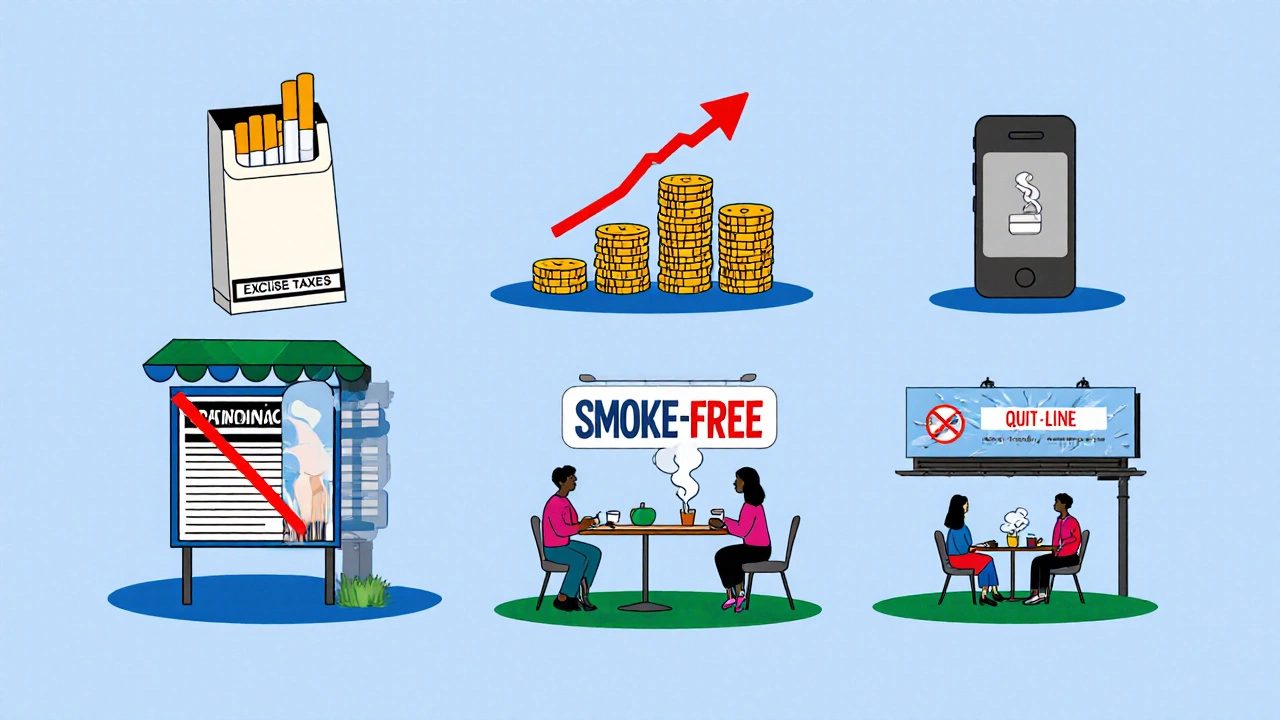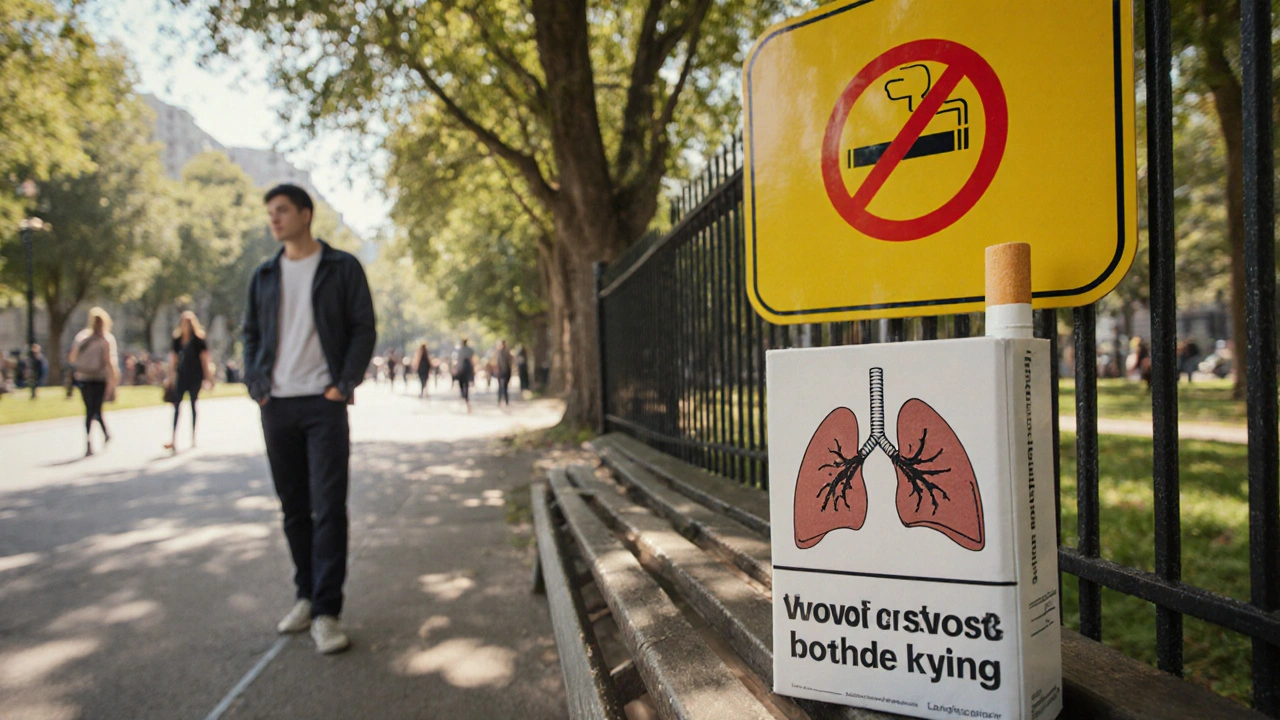Tobacco Tax Impact Calculator
Learn how a 10% increase in tobacco taxes can reduce smoking prevalence by 4% (adults) or 7% (youth), and the resulting health and economic benefits.
Results
Methodology: Based on WHO data showing a 4% reduction in adult smoking per 10% price increase and 7% for youth. Health benefits calculated using CDC estimates of 1.5 million premature deaths prevented per decade for a 10% price increase.
When you see a cigarette pack covered in graphic warnings or a city park where smoking is prohibited, you’re looking at the result of tobacco regulation. Governments around the world have stepped in to curb the health toll of tobacco, but the tools they use and the reasons behind each move vary a lot. This guide walks through why governments act, which policy levers they have, real‑world examples, and the hurdles they still face.
Why Governments Step In
Governments are the primary decision‑makers that set laws, collect taxes, and allocate health budgets. Their involvement in tobacco stems from three core concerns:
- Public health impact: Smoking kills more than 8 million people each year globally, according to the World Health Organization. Reducing that number saves lives and cuts long‑term medical costs.
- Economic burden: The cost of treating tobacco‑related diseases can equal up to 5% of a country’s GDP. Taxes on tobacco help offset these expenses.
- Social equity: Low‑income groups tend to smoke more, so policies that make cigarettes less affordable or attractive can narrow health disparities.
These motivations are reflected in the World Health Organization Framework Convention on Tobacco Control (WHO FCTC), an international treaty that obliges signatories to adopt evidence‑based measures such as excise taxes, advertising bans, and plain packaging.
Main Regulatory Tools
Governments use a toolbox that mixes fiscal, market, and informational strategies. Below are the most common levers.
Excise Taxes
Raising the price of cigarettes is the single most effective way to reduce consumption, especially among young people. A 10% price hike can cut adult smoking by about 4% and youth smoking by up to 7%.
Advertising and Promotion Bans
Many jurisdictions outlaw tobacco advertising on TV, radio, billboards, and social media. The goal is to deprive the industry of channels that recruit new smokers.
Plain Packaging
Plain packaging removes brand colors, logos, and promotional images from cigarette packs, leaving only the health warnings. Australia’s 2012 rollout showed a 7% drop in smoking prevalence after five years.
Health Warning Labels
Graphic warnings covering at least 50% of the front and back of packs make the health risks unavoidable. Studies in Canada and the UK report a 5‑10% increase in risk perception after implementing larger warnings.
Age Restrictions and Sales Controls
Most countries set the legal purchase age at 18 or 21. Coupled with enforcement checks, these limits reduce under‑age access.
Smoke‑Free Public Spaces
Ban smoking in bars, restaurants, workplaces, and outdoor public areas. Such policies not only protect non‑smokers from secondhand smoke but also denormalize smoking behavior.
Cessation Support
Providing free quit‑lines, nicotine replacement therapy, and counseling multiplies the effect of other policies by helping smokers quit when they’re ready.

Real‑World Examples
The mix of measures varies by region, but some cases illustrate how a focused approach can work.
| Country | Excise Tax (% of retail price) | Plain Packaging | Advertising Ban | Smoke‑Free Public Spaces |
|---|---|---|---|---|
| Australia | 70% | Yes (since 2012) | Comprehensive | All indoor & most outdoor |
| United Kingdom | 68% | Yes (since 2016) | Comprehensive | All indoor & many outdoor |
| Canada | 65% | No (but large warnings) | Comprehensive | All indoor, most outdoor |
| United States (federal) | 48% | No | Partial (TV, radio) | Varies by state |
Australia leads with the highest tax rate and early adoption of plain packaging, while the United States relies more on state‑level bans and less aggressive taxation.
Canada’s Provincial Patchwork
Each province sets its own tax level, ranging from 58% in Alberta to 70% in Nova Scotia. The federal government mandates graphic health warnings covering 75% of pack surfaces. Quebec was the first to ban smoking in outdoor patios of restaurants, a rule now common across most provinces.
UK’s ‘Smoke‑Free England’ Initiative
Backed by the Department of Health and Social Care, this campaign combines a 68% tax, a complete advertising ban, and mandatory plain packaging. Since 2017, smoking rates have dropped from 14.9% to 13.4% among adults.
Impact on Public Health
Multiple studies confirm that the stronger the policy mix, the bigger the health gains.
- Reduced prevalence: Nations with tax rates above 70% see smoking prevalence under 10%.
- Lower disease burden: The CDC estimates that a 10% price increase prevents 1.5 million premature deaths over a decade.
- Economic savings: The OECD calculates that every dollar raised from tobacco taxes returns about $2‑$3 in healthcare cost reductions.
Importantly, the benefits are not uniform. Young adults respond most to price hikes, while older smokers are more influenced by cessation programs and warning labels.
Challenges and Pushback
Even with solid evidence, governments hit roadblocks.
Illicit Trade
Higher taxes can fuel smuggling, especially in regions with weak customs enforcement. The WHO estimates that illicit cigarettes account for 11% of the global market. Counter‑measures include track‑and‑trace systems and harsher penalties.
Industry Lobbying
The tobacco industry spends billions on legal battles and public‑relations campaigns. In the United States, groups like the Tobacco Institute have historically influenced legislation to keep taxes low and advertising restrictions weak.
Political Will
Policy adoption often hinges on elections and public opinion. When governments perceive tobacco control as unpopular among certain voter blocs, they may delay or dilute measures.
Future Directions
Looking ahead, several trends are shaping the next wave of regulation.
- End‑game targets: Countries like NewZealand aim to reduce smoking prevalence to under 5% by 2025 through aggressive tax hikes and a ban on new tobacco products.
- Novel products: E‑cigarettes and heated tobacco demand new regulatory categories, balancing harm‑reduction potential with youth uptake concerns.
- Digital enforcement: AI‑driven monitoring of online sales helps curb illegal purchases, especially in low‑regulation markets.
Governments that stay adaptable-updating tax schedules annually, expanding plain packaging rules, and investing in real‑time data-will likely see the greatest health dividends.
Key Takeaways
- Governments act on tobacco because of clear health, economic, and equity motives.
- Excise taxes, advertising bans, plain packaging, and smoke‑free laws form the core policy toolbox.
- Australia, the UK, and Canada illustrate how a strong, coordinated mix drives prevalence down.
- Illicit trade and industry lobbying remain the biggest obstacles.
- Future success depends on flexible tax policies, regulation of emerging nicotine products, and digital enforcement tools.
Frequently Asked Questions
What is the WHO Framework Convention on Tobacco Control?
The WHO FCTC is the first global public‑health treaty. Signed in 2003, it obliges parties to adopt evidence‑based measures like higher taxes, advertising bans, and graphic health warnings to curb tobacco use.
How effective are tobacco taxes at reducing smoking?
Price elasticity studies show that a 10% price increase cuts overall consumption by about 4% and youth consumption by up to 7%. High‑tax countries consistently report lower smoking prevalence.
Does plain packaging really make a difference?
Evidence from Australia, the UK, and France indicates a 5‑7% reduction in smoking rates after plain packaging is introduced, plus a measurable rise in quit attempts.
What age limits are common for buying tobacco?
Most nations set the minimum purchase age at 18. Some, like the United States (certain states) and Ireland, have raised it to 21 to further curb youth initiation.
How do governments combat illicit tobacco trade?
Key strategies include track‑and‑trace barcode systems, higher penalties for smugglers, cross‑border cooperation, and public awareness campaigns about the dangers of unregulated products.








20 Comments
Harshal Sanghavi
October 12, 2025 AT 17:42So governments finally got the memo that making tobacco pricier actually cuts down smoking-what a surprise, right? The tax hikes are like a blunt scalpel; they slice through the cheap‑cig market and force folks to think twice. I get that some smokers will look for loopholes, but the data is crystal clear: higher prices = fewer packs sold. Keep the enforcement tight and watch the prevalence tumble. 🙄 (just kidding, no emojis here).
Duke Gavrilovic
October 15, 2025 AT 01:15The overview nicely stitches together the public‑health rationale, the fiscal incentives, and the equity concerns. It’s impressive how the WHO framework provides a common language for nations, yet each country tailors its toolbox to local realities. From taxes to plain packaging, the synergy is evident. I especially appreciate the tidy tables that compare policy mixes across continents.
Abby VanSickle
October 17, 2025 AT 08:49Your summary captures the urgency of tobacco control with a respectful tone. The emphasis on health equity resonates, especially given how low‑income groups bear the brunt of smoking‑related illnesses. It’s clear that taxation, advertising bans, and smoke‑free zones work best when rolled out together. The data on lives saved adds a compelling human dimension to the policy discussion.
chris macdaddy
October 19, 2025 AT 16:22Totally agree with what you said above-taxes really do the heavy lifting. I’d throw in that making quit‑lines free can boost the effect, especially for folks who already feel the pinch. Sorry for the typo, but I think we can all see the bigger picture here.
Keep pushing for those plain packages; they’re a game‑changer.
Moumita Bhaumik
October 21, 2025 AT 23:55Everyone loves to pat themselves on the back for a tax hike while the big tobacco lobby slips a dozen loopholes under the radar. Think about the shadow market that flourishes whenever you raise prices-smugglers, counterfeit packs, you name it. The industry’s influence is still massive, and the “public‑health” narrative is often just a PR cover.
Sheila Hood
October 24, 2025 AT 07:29Ah, the ol' conspiracy angle-always a fun detour. In reality, the evidence shows that strict tax regimes shrink the black market when paired with robust track‑and‑trace. The data from Australia and the UK proves that the industry can’t simply outmaneuver well‑designed policies.
Melissa Jansson
October 26, 2025 AT 15:02Let’s dissect the policy stack with a bit of jargon: the taxation elasticity coefficient, the advertising saturation index, and the packaging obfuscation metric-all of which converge to produce a negative consumption gradient. While some critics whine about ‘personal freedom’, the epidemiological impact is unmistakable. The cocktail of measures is akin to a multi‑modal intervention strategy, optimized for maximum public‑health yield.
Max Rogers
October 28, 2025 AT 22:35Nice overview, thanks!
Louie Hadley
October 31, 2025 AT 06:09I appreciate the balanced tone of the guide. It lays out the facts without resorting to alarmism, which is refreshing. The mix of fiscal and informational levers makes sense, especially when we consider the varied cultural contexts.
Ginny Gladish
November 2, 2025 AT 13:42From an analytical standpoint, the presented data aligns with the elasticity estimates found in the literature. A 10% price increase leading to a 4% drop in adult smoking is consistent with meta‑analyses across high‑income nations. Moreover, the revenue‑to‑health‑savings ratio mentioned-$2‑$3 per dollar-fits the OECD projections.
Faye Bormann
November 4, 2025 AT 21:15Looking ahead, the trajectory of tobacco regulation is set to intersect with emerging nicotine delivery systems, creating a complex regulatory frontier. First, the rise of e‑cigarettes and heated tobacco products challenges traditional tax structures, which were designed for combustible cigarettes. Policymakers must decide whether to levy equivalent taxes or adopt a risk‑based tiered approach. Second, the digital marketplace enables cross‑border sales that evade national excise duties, prompting the need for innovative enforcement mechanisms like blockchain‑based traceability. Third, public sentiment continues to evolve as younger cohorts view vaping as socially acceptable, which could either dilute or reinforce anti‑tobacco norms depending on how health messaging is framed. Fourth, the global health community is advocating for “end‑game” targets, such as New Zealand’s goal of sub‑5% smoking prevalence by 2025, which may inspire other nations to set similarly ambitious milestones. Fifth, the industry’s lobbying power remains a formidable obstacle; however, transparency initiatives-like mandatory disclosure of political contributions-can mitigate undue influence. Sixth, the integration of real‑time surveillance data, powered by AI, promises to identify hotspots of illicit trade swiftly, allowing targeted interdiction. Seventh, plain packaging legislation continues to gain traction beyond the traditional adopters, with countries in Asia and Latin America piloting variations of the policy. Eighth, health warning label design is being refined using behavioral economics insights, ensuring that messages are not only graphic but also emotionally resonant. Ninth, cessation support is expanding through telehealth platforms, making nicotine replacement therapies more accessible, especially in underserved areas. Tenth, fiscal sustainability is a concern; governments must balance revenue generation with the public‑health imperative of reducing consumption. Eleventh, cross‑sector collaboration-between health ministries, finance departments, and customs agencies-will be essential for coherent policy implementation. Twelfth, community engagement remains a cornerstone, as grassroots campaigns can amplify the impact of top‑down regulations. Thirteenth, equity considerations must stay front‑and‑center, ensuring that tax hikes do not disproportionately burden vulnerable populations without providing adequate support. Fourteenth, ongoing research into the long‑term health outcomes of novel nicotine products will inform future regulatory adjustments. Fifteenth, ultimately, the success of any tobacco control strategy hinges on political will, sustained public advocacy, and a willingness to adapt to an ever‑changing market landscape.
Kathy Butterfield
November 7, 2025 AT 04:49Wow, that was a marathon of insights! 🚀 I especially liked the bit about AI helping spot illegal sales. It feels like we’re finally catching up with the tech‑savvy tobacco industry.
Zane Nelson
November 9, 2025 AT 12:22The treatise, while exhaustive, borders on pedantry. One could argue that a concise executive summary would serve policymakers better than this labyrinthine exposition.
Sahithi Bhasyam
November 11, 2025 AT 19:55Thx for the deets!! 🙌 I think u missed a couple of 🇮🇳 stats, but overall g00d job. The emojis add a nice touch!!!
mike putty
November 14, 2025 AT 03:29It’s uplifting to see so many evidence‑based tools at our disposal. With continued collaboration, we can keep lowering smoking rates and saving lives.
Kayla Reeves
November 16, 2025 AT 11:02While the data is solid, we must not forget the moral imperative: a society that tolerates addiction is failing its most vulnerable members.
Abhinanda Mallick
November 18, 2025 AT 18:35Our nation’s heritage deserves protection from the insidious grip of foreign tobacco conglomerates. A robust tax regime is not merely fiscal policy; it’s a declaration of sovereignty.
Amanda Anderson
November 21, 2025 AT 02:09Well said. Simple steps like higher taxes and plain packs can make a huge difference.
Carys Jones
November 23, 2025 AT 09:42It’s ethically indefensible to let big tobacco continue its predatory practices while we sit idle. Let’s demand stronger action now.
Roxanne Porter
November 25, 2025 AT 17:15I concur with the preceding points and would add that collaborative policymaking, rooted in rigorous evidence, will ensure sustainable progress.